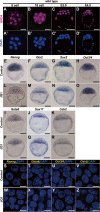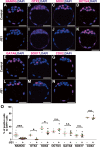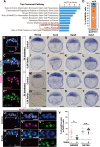BET proteins are essential for the specification and maintenance of the epiblast lineage in mouse preimplantation embryos
- PMID: 35264162
- PMCID: PMC8905768
- DOI: 10.1186/s12915-022-01251-0
BET proteins are essential for the specification and maintenance of the epiblast lineage in mouse preimplantation embryos
Abstract
Background: During mammalian preimplantation development, as the fertilized egg develops and differentiates, three cell lineages become specified: trophectoderm (TE), epiblast, and primitive endoderm (PrE). Through two steps of cell fate decisions, 16-cell blastomeres develop into TE and an inner cell mass (ICM), and thereafter, the latter differentiates into pluripotent epiblast and PrE. Although bromodomain and extra-terminal domain (BET) proteins, such as BRD4, are necessary for the transcriptional activation of genes involved in the maintenance of mouse embryonic stem cells by occupying their enhancers, their roles in the development of mouse preimplantation are unknown.
Results: To evaluate the effect of BET protein deficiency on cell lineage formation, we cultured preimplantation embryos in the presence of JQ1, which blocks the binding of BET bromodomains to acetylated-histones. We found BET inhibition blocked the transcriptional activation of genes, such as Nanog, Otx2, and Sox2, important for the formation of the epiblast lineage in blastocysts. Expression studies with lineage-specific markers in morulae and blastocysts revealed BET proteins were essential for the specification and maintenance of the epiblast lineage but were dispensable for the formation of primarily extraembryonic TE and PrE lineages. Additional Ingenuity Pathway Analysis and expression studies with a transcriptionally active form of signal transducer and activator of the transcription 3 (STAT3) suggested BET-dependent activation was partly associated with the STAT3-dependent pathway to maintain the epiblast lineage. To identify BET proteins involved in the formation of the epiblast lineage, we analyzed mutant embryos deficient in Brd4, Brd2, and double mutants. Abolishment of NANOG-positive epiblast cells was only evident in Brd4/Brd2 double-deficient morulae. Thus, the phenotype of JQ1-treated embryos is reproduced not by a Brd4- or Brd2-single deficiency, but only Brd4/Brd2-double deficiency, demonstrating the redundant roles of BRD2 and BRD4 in the specification of the epiblast lineage.
Conclusions: BET proteins are essential to the specification and maintenance of the epiblast lineage by activating lineage-specific core transcription factors during mouse preimplantation development. Among BET proteins, BRD4 plays a central role and BRD2 a complementary role in the specification and maintenance of epiblast lineages. Additionally, BET-dependent maintenance of the epiblast lineage may be partly associated with the STAT3-dependent pathway.
Keywords: BET; Blastocyst; Brd2; Brd4; Bromodomain; Epiblast; Inner cell mass; JQ1; Mouse; Nanog.
© 2022. The Author(s).
Conflict of interest statement
The authors declare that they have no competing interests.
Figures







Similar articles
-
Lineage segregation in human pre-implantation embryos is specified by YAP1 and TEAD1.Hum Reprod. 2023 Aug 1;38(8):1484-1498. doi: 10.1093/humrep/dead107. Hum Reprod. 2023. PMID: 37295962
-
NANOG initiates epiblast fate through the coordination of pluripotency genes expression.Nat Commun. 2022 Jun 21;13(1):3550. doi: 10.1038/s41467-022-30858-8. Nat Commun. 2022. PMID: 35729116 Free PMC article.
-
PI3K/AKT signaling controls ICM maturation and proper epiblast and primitive endoderm specification in mice.Dev Cell. 2025 Jan 20;60(2):204-219.e6. doi: 10.1016/j.devcel.2024.10.001. Epub 2024 Oct 25. Dev Cell. 2025. PMID: 39461340
-
A close look at the mammalian blastocyst: epiblast and primitive endoderm formation.Cell Mol Life Sci. 2014 Sep;71(17):3327-38. doi: 10.1007/s00018-014-1630-3. Epub 2014 May 4. Cell Mol Life Sci. 2014. PMID: 24794628 Free PMC article. Review.
-
Journey of the mouse primitive endoderm: from specification to maturation.Philos Trans R Soc Lond B Biol Sci. 2022 Dec 5;377(1865):20210252. doi: 10.1098/rstb.2021.0252. Epub 2022 Oct 17. Philos Trans R Soc Lond B Biol Sci. 2022. PMID: 36252215 Free PMC article. Review.
Cited by
-
Regulation of Myc transcription by an enhancer cluster dedicated to pluripotency and early embryonic expression.Nat Commun. 2024 May 10;15(1):3931. doi: 10.1038/s41467-024-48258-5. Nat Commun. 2024. PMID: 38729993 Free PMC article.
-
Key chromatin regulator-related genes associated with the risk of coronary artery disease regulate the expression of HCFC1, RNF8, TNP1 and SET.Heliyon. 2024 Mar 29;10(7):e28685. doi: 10.1016/j.heliyon.2024.e28685. eCollection 2024 Apr 15. Heliyon. 2024. PMID: 38596069 Free PMC article.
-
Divergent destinies: insights into the molecular mechanisms underlying EPI and PE fate determination.Life Sci Alliance. 2025 Jan 8;8(3):e202403091. doi: 10.26508/lsa.202403091. Print 2025 Mar. Life Sci Alliance. 2025. PMID: 39779220 Free PMC article. Review.
-
BET activity plays an essential role in control of stem cell attributes in Xenopus.Development. 2024 Jul 1;151(13):dev202990. doi: 10.1242/dev.202990. Epub 2024 Jul 3. Development. 2024. PMID: 38884356 Free PMC article.
References
Publication types
MeSH terms
Substances
LinkOut - more resources
Full Text Sources
Molecular Biology Databases
Research Materials
Miscellaneous

